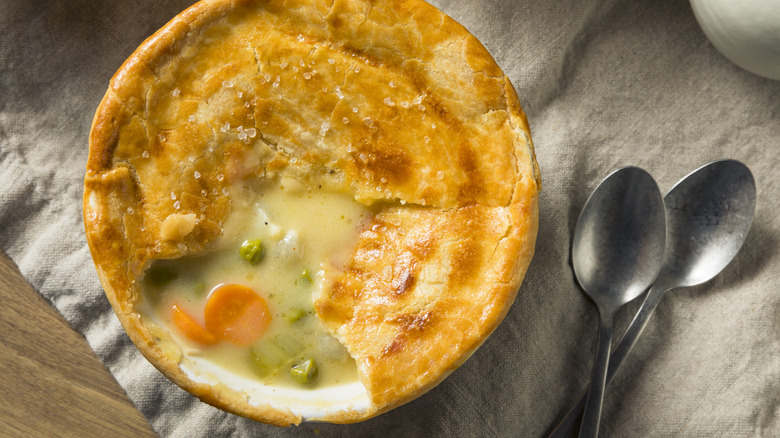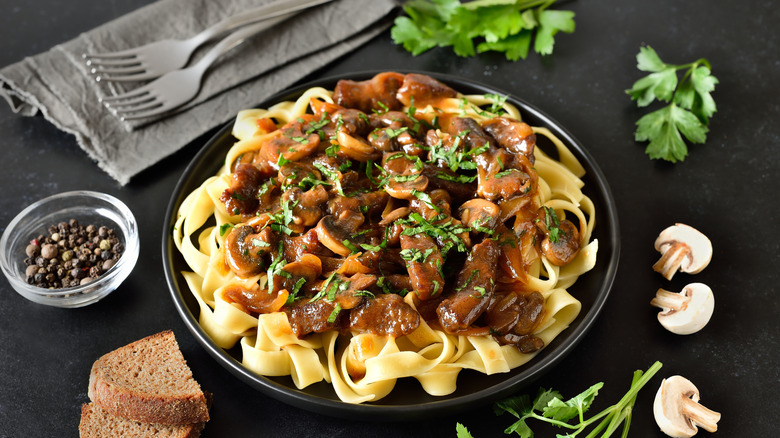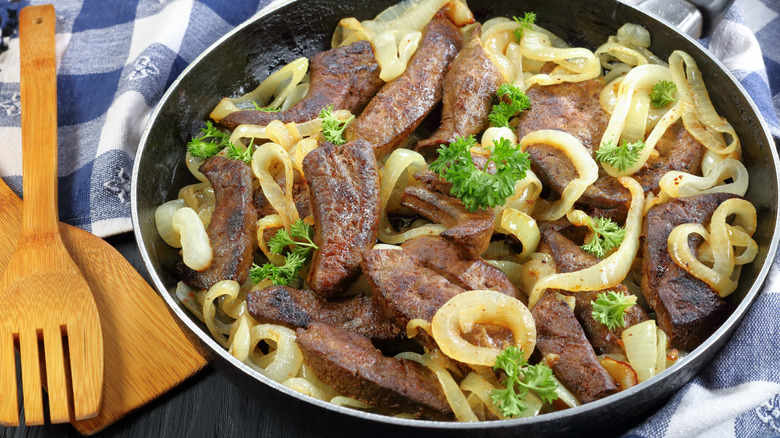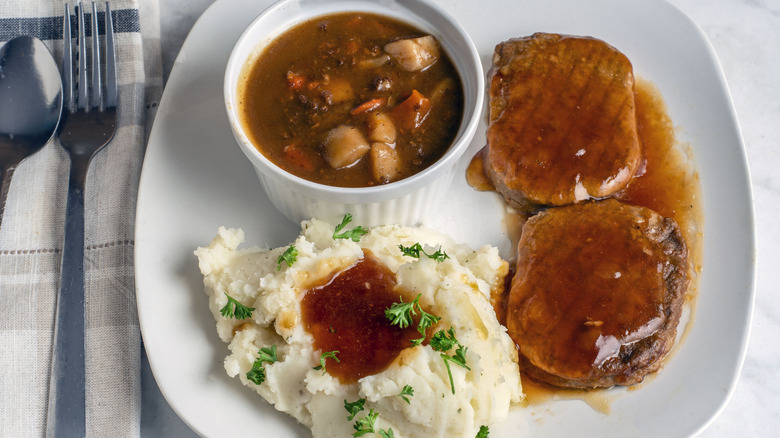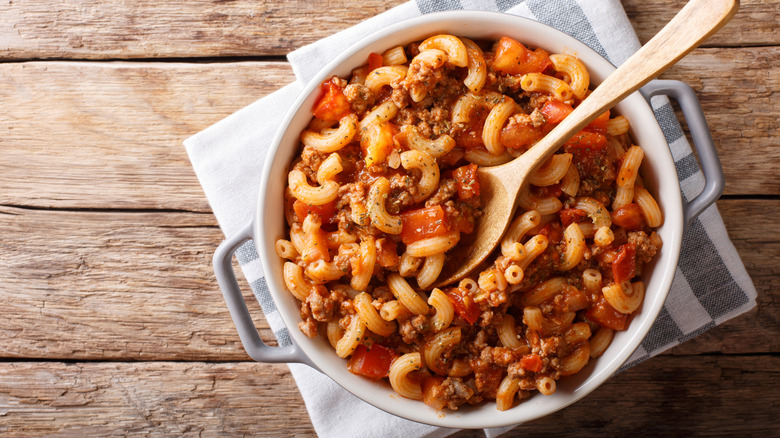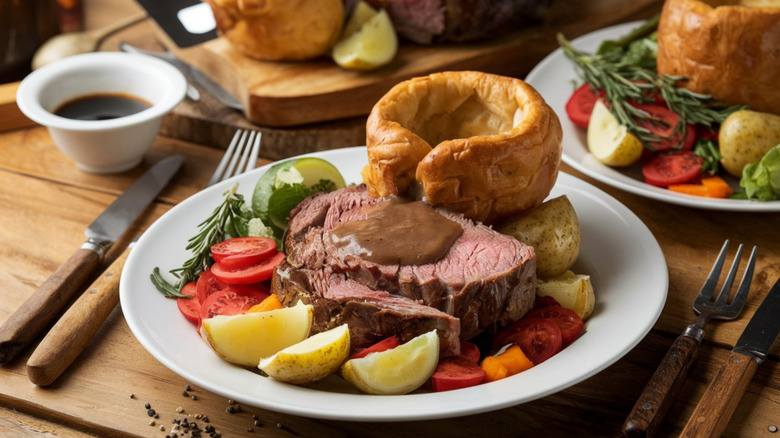Grandma's Old-School Sunday Dinners That Rarely Show Up On Tables Today
Among the many old traditions that we've lost to a quickly changing culture, few are lamented quite like Sunday dinner. In the 1800s and early 1900s, "blue laws" prohibited work, shopping, public entertainment, and other operations on Sundays. Many went to church in the mornings, had a big family dinner afterward, and did little else. Sundays were reserved for rest, contemplation, and cooking.
The menu for Sunday dinner could vary by household, region, or season. The commonality was that, even as modern conveniences entered the kitchen, grandma's Sunday dinner remained decidedly old-fashioned, served family-style for sharing and lingering. Some dishes became so attached to Sunday to incorporate the day in their name, like Sunday sauce and Sunday gravy, or Sunday roast.
With blue laws mostly a thing of the past and families spread out across cities and states, the traditional Sunday dinner is basically obsolete. But that doesn't mean we can't reinvent the ritual for modern life. Let's look back at some of grandma's old-school Sunday dinners; Perhaps we can find a few worth bringing back.
Chicken pot pie
The classic chicken pot pie originated as a clever way to stretch leftovers, brought to the U.S. via European settlers. Over time, the recipe evolved into what it is today: A sturdy pie shell encasing a savory mixture of minced vegetables and, of course, chicken.
For years, chicken pot pie's combination of rich, creamy stew and flakey, buttery pastry was considered the height of American cuisine, at least by some. Some regions even put their own spin on it, with Pennsylvania adding square-shaped noodles to a brothy filling. The cooking process was laborious, but the results were delicious, making it an obvious choice for an old-school Sunday dinner.
In the early 1950s, amid the flurry of invention that modern refrigeration brought, C.A. Swanson introduced a frozen chicken pot pie to the market. The dish proved to be particularly well suited to freezing and reheating, and with so many great store-bought chicken pot pies on the market today, it's been transformed into a convenience food, more likely to show up in a college dorm than on grandma's dinner table. But if you find the time to make your own chicken pot pie from scratch, or even cut a few corners with a semi-homemade Quick Chicken Pot Pie, you'll be handsomely rewarded.
Beef stroganoff
From Russian peasant food to international acclaim, beef stroganoff comes attached with a story. Legend has it, the dish was catapulted into the spotlight when a French chef was tasked with cooking for Count Grigory Stroganov, whose teeth had become so weak that he could no longer eat steak. The chef cooked cubes of meat until tender, served them in a rich cream sauce over egg noodles, and the rest is history. Whether or not the tale is true, it speaks to the tenderness of the beef that stars in this cozy classic, made all the more savory by mustard, mushrooms, and sour cream.
Throughout the twentieth century, beef stroganoff experienced a fascinating transformation. The "set it and forget it" cooking method had it instantly embraced by American home chefs. Grandma could leave the beef to simmer as she spent time with her family, and everyone would enjoy the results for Sunday dinner. After the invention of the Crock Pot in the 1970s, slow-cooker beef stroganoff became a weeknight wonder, no longer requiring long hours in the kitchen. Then, in the 1980s, Lean Cuisine launched its line of healthy frozen dinners, including a calorie-conscious beef stroganoff. Nowadays, that's what people recall when they think of beef stroganoff, instead of the traditional version synonymous with old-school, homestyle cooking.
Hamburg steak
Americans love ground beef. It's found in countless soups, sauces, tacos — and yet, the simple hamburger remains among the most popular uses. It's a bit strange, then, that its equally delicious and versatile precursor has fallen by the wayside.
The traditional Hamburg steak is a bunless burger served on a plate with sides like potato salad, vegetables, and toast. It was once a popular menu item in diners and delis, and many families also enjoyed it at home. When grandma wasn't in the mood to simmer or braise, this is a recipe she might have reached for instead.
While the history of the hamburger in America is widely contested, the Hamburg steak is clearly an evolution of German frikadellen, or seasoned meat patties made to stretch leftover beef. They can (and should) be smothered in gravy for extra flavor, and perhaps topped with mushrooms or onions. Germans continue to eat them this way but, as Americans prefer their burgers on buns, the popularity of Hamburg steak has waned.
Liver and onions
Liver, as a food, is known as much for its high nutritional value as for its polarizing flavor. While many won't touch the stuff, others love liver and onions, an old-fashioned dish that once graced many Sunday dinner tables.
After the Great Depression and World War II, families facing economic hardship relied on organ meat for inexpensive sustenance. Liver was cheap, packed with iron and protein, and easy to prepare according to English tradition. True to its name, a dish of liver and onions has two main ingredients: slices of liver (typically beef if you're American, lamb if you're English) and onions, whose sweetness serves to balance the richness of the liver. The two are fried together in butter or lard, then served over mashed potatoes, covered in pan gravy.
For a time, liver and onions was so commonly enjoyed that it was given its own holiday (May 10th, if you're curious) but tastes have changed. While it's still enjoyed by some, especially in the upper-Midwest, liver and onions is no longer on regular rotation in most American households, likely due to the mixed reception it receives. Trends are cyclical, so perhaps liver and onions will become popular again someday. In the meantime, grandma's probably serving something else.
Salisbury steak
Salisbury steak is made with ground beef as well as fillers like minced onion, egg, and breadcrumbs. It arrived in America by way of Navy cookbooks, and was named for Dr. J.H. Salisbury. In the mid-1800s, Dr. Salisbury was a big proponent of a meat-based diet for optimal health. Not only was his namesake dish both filling and tasty, but it also served to stretch ground beef in times of financial stress. That's what made Salisbury steak a dish to look forward to, often showing up on families' dinner tables on Sunday.
Salisbury steak became so popular that it made its way into school cafeterias, and in hindsight, that's probably where its downfall began. Inexpensive, high in calories, and easy to make in large batches, the dish was a great fit for feeding school children — or so administrators thought. The school children didn't necessarily agree, and collectively rebranded Salisbury steak as "mystery meat."
Along with its new, negative name, Salisbury steak was hit by Americans' evolving understanding of nutrition. Today's grandmothers know all too well that this isn't a healthy food, which led to its downfall. If you're interested in trying a new-and-improved version of this classic, consider Bobby Flay's tips for Salisbury steak.
Tuna noodle casserole
In 1950s Middle America, tuna noodle casserole was everywhere. You couldn't go to a church potluck or family gathering without it, and it was often on heavy rotation at grandma's house. Its popularity could be attributed to the fact that it was tasty, sure, but also that it was made with all shelf-stable ingredients. This was no accident. In fact, while a recipe for "Noodles and Tuna Fish en Casserole" appeared in a 1930 issue of Sunset Magazine, and other versions of the dish were around before that, the tuna noodle casserole that we know today was invented in the '40s by Campbell's to highlight the brand's cream of mushroom soup, as well as other pantry staples.
From school cafeterias to Sunday dinner, tuna noodle casserole was one of America's favorite foods for decades. It's still nutritious and easy to make (pour everything into a casserole dish, and pop it into the oven) but it's rarely served now. Trends have turned away from dump-and-bake casseroles, and now favor other ways to eat tinned fish. To bring the nostalgic dish on par with today's standards, try one of these modern twists on tuna casserole that grandma would surely approve of.
American goulash
Like so many of the foods invented in America, American goulash is a riff on another country's dish. It evolved from a Hungarian hunters' stew, made with hearty chunks of meat and heavily spiced with paprika and chili powder. While the American version also uses paprika and pepper, little else is the same. The traditional meat is swapped for quick-cooking ground beef, and pasta (typically elbow macaroni) is added directly to the pot for heft. From there, the dish changes depending on whose grandma's recipe you're following. Some add beans or chunks of tomato. Others top the entire thing with melted cheddar cheese. Most agree it's satisfying, even as American goulash has left the regular rotation.
If you're wondering why American families have stopped making their once-beloved goulash, you might find the reason at your local grocery store, in a box bearing the friendly face of Lefty the anthropomorphic glove. Since General Mills launched the brand in 1971, Helper (formerly Hamburger Helper) has taken the place of many from-scratch dinners, including the American goulash that inspired its original flavor. These days, you're more likely to find that version on the dinner table than the old-school meal grandma used to make.
Chicken Kiev
A stuffed chicken dish with a misleading name, Chicken Kiev is not Ukrainian, but French. It originated in Paris, became famous in Russia, and went on to charm diners worldwide. Chicken Kiev is a pounded and breaded chicken breast rolled around a mixture of butter and herbs that melts during the cooking process. When it's cut into, the molten liquid oozes (or even explodes, as this writer once discovered) from the chicken, making for an exciting eating experience. If you like your comfort food with a bit of drama, you'll like Chicken Kiev. Unfortunately, unless you're somehow reading this in the 1940s, you might find the dish hard to come by.
In the first half of the twentieth century, Americans loved Chicken Kiev. It was tricky to make, but worth the effort. If your grandma was particularly glamorous, she would have served this on Sunday. So, why does no one eat Chicken Kiev anymore? It's hard to say, but the answer is likely some combination of time constraints, modern conveniences, and changing preferences. The dish takes time to perfect from scratch, and the fact that frozen versions are now available from multiple brands makes it seem less fancy. But if you ask us, this is one old-school dinner that deserves a comeback.
Jell-O salad
Oddly futuristic and questionably nutritious, Jell-O salad was the quintessential midcentury food. If you attended a dinner party in America in the 1950s, or enjoyed a leisurely Sunday dinner at grandma's house, chances are high that some version of Jell-O salad was served — and there were many versions to choose from. Part of the dish's allure, at least to the one making it, was the variety. Jell-O salad could be sweet or savory, filled with everything from Maraschino cherries to pimentos to cottage cheese (yes, really) before being packed into a bundt pan or specialized mold. Each new version was more creative than the last.
Along with being fun to make and display, Jell-O salad was loved by home chefs for the fact that it could be fixed ahead of time. In fact, it had to be; The gelatin needed time to set in the fridge. This made it perfect for prepping before church on Sunday, and then serving for dinner after. Despite the fun and ease, it's no mystery why Jell-O salad has disappeared from the American dinner table. While there are certainly many tasty variations to try, like strawberry-topped Jell-O Pretzel Salad, there are even more to steer clear from. Take one look at this retro aspic salad, Jell-O salad's savory cousin, and you'll see why the fad has faded from Sunday dinner.
Sunday roast
If your grandma was a purist, or maybe just British, her go-to Sunday dinner was a classic Sunday roast. This was a large-format protein, like a shoulder of lamb or rib roast, served with all the fixings. There could have been glazed carrots, or mashed potatoes with gravy, or perhaps even a traditional Yorkshire pudding, but the focal point was the meat.
The Sunday roast was once a beloved food tradition, brought to the U.S. by way of the U.K. It was as much a fixed appointment on the calendar as going to church: The family would head out to worship while the roast stayed home in the oven, and then afterward, they would feast (and yes, the meat was often overcooked.) As church attendance has dropped in recent years, so have the adjacent rituals. Instead of a Sunday roast, we now have Sunday brunch, swapping the gratins and pan jus gras for hashbrowns and hollandaise. Whether this is better or worse, of course, is entirely up to you.

